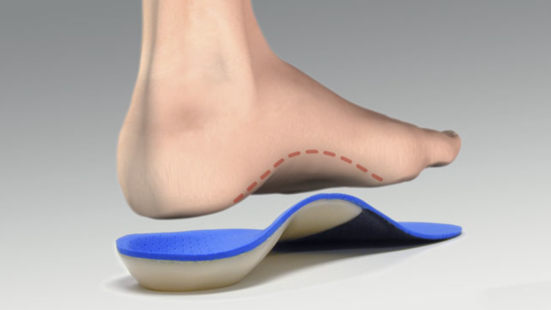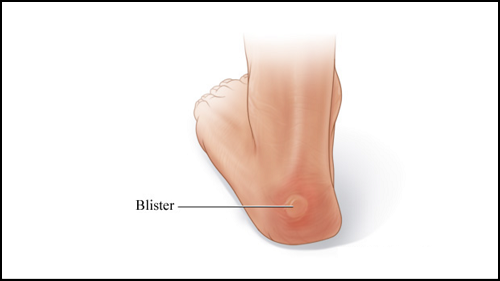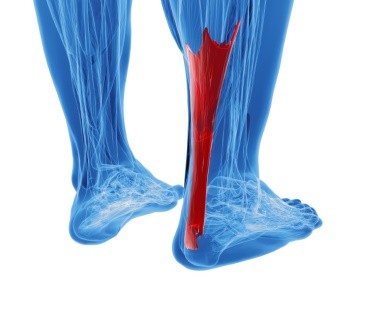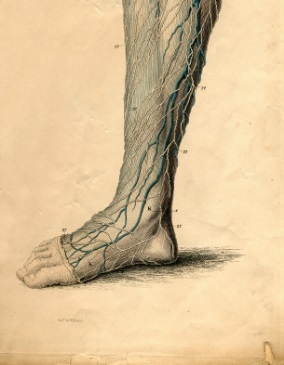Blog
Foot Pain relievable for the Elderly with Extra-depth Footwear
 According to a new study, adults over the age of 65 who were fitted for new extra-depth shoes experienced reduced pain and improved function. While extra-depth footwear is often marketed for people with diabetic foot conditions, lead author Hylton B. Menz stated that the structure and function of the foot changes greatly with age regardless of diabetic status. “With advancing age, there is a general tendency for the foot to exhibit increased soft tissue stiffness, decreased range of motion, decreased strength, and a more pronated posture,” said Menz. Many of the elderly also do not wear proper fitting shoes that accommodate to the changed shape of the feet. Those in the study wearing extra-depth footwear were more likely to report their foot pain had moderately or markedly improved and developed fewer podiatric skin conditions than the comparison group.
According to a new study, adults over the age of 65 who were fitted for new extra-depth shoes experienced reduced pain and improved function. While extra-depth footwear is often marketed for people with diabetic foot conditions, lead author Hylton B. Menz stated that the structure and function of the foot changes greatly with age regardless of diabetic status. “With advancing age, there is a general tendency for the foot to exhibit increased soft tissue stiffness, decreased range of motion, decreased strength, and a more pronated posture,” said Menz. Many of the elderly also do not wear proper fitting shoes that accommodate to the changed shape of the feet. Those in the study wearing extra-depth footwear were more likely to report their foot pain had moderately or markedly improved and developed fewer podiatric skin conditions than the comparison group.
Maintaining proper foot care is essential for the older adult. For more information about foot care for the elderly, consult with podiatrists Dr. Michael Newman and Dr. Denise Kohler of Pennsylvania. Our doctors will assist you with all of your foot and ankle concerns and provide you with quality treatment.
The Elderly and their Feet
As we age we start to notice many changes in our body, but the elder population may not notice them right away. Medical conditions may prevent the elderly to take notice of their foot health right away. Poor vision is a lead contributor to not taking action for the elderly.
Common Conditions
Neuropathy – can reduce feeling in the feet, and can hide many life threating medical conditions.
Reduced flexibility – prevents the ability of proper toenail trimming, and foot cleaning. If left untreated, it may lead to further medical issues.
Foot sores – amongst the older population can be serious before they are discovered. Some of the problematic conditions they may face are:
Gouging toenails affecting nearby toe
Shoes that don’t fit properly
Pressure sores
Loss of circulation in legs & feet
Edema & swelling of feet and ankles
Susceptible Infections
Diabetes and poor circulation can cause general loss of sensitivity over the years, turning a simple cut into a serious issue.
For more information about Elderly and Feet, follow the link below.
If you have any questions please feel free to contact one of our offices located in Ambler and Plymouth Meeting, PA. We offer the latest in diagnostic and treatment technology to meet your needs.
Read more about Elderly and Feet
Blistered Feet do not deter Natalie Imbruglia’s Hike across Switzerland
 Natalie Imbruglia revealed extremely swollen and blistered feet after hiking over one hundred miles across Switzerland. As a part of the Strive challenge, the Australian actress and singer embarked on a seven-day journey across Switzerland on August 23rd. The challenge was in support of non-profit organization Virgin Money Giving, which is raising funds for projects dedicated to changing the way young people think. Imbruglia had a physiologist visit and tape up her beaten feet on the sixth day of her journey. The hike spanned from Switzerland’s south-western village of Verbier all the way to Zermatt in the Swiss Alps.
Natalie Imbruglia revealed extremely swollen and blistered feet after hiking over one hundred miles across Switzerland. As a part of the Strive challenge, the Australian actress and singer embarked on a seven-day journey across Switzerland on August 23rd. The challenge was in support of non-profit organization Virgin Money Giving, which is raising funds for projects dedicated to changing the way young people think. Imbruglia had a physiologist visit and tape up her beaten feet on the sixth day of her journey. The hike spanned from Switzerland’s south-western village of Verbier all the way to Zermatt in the Swiss Alps.
Untreated blisters can worsen and make mobility extremely difficult and painful. For quality blister treatment, see one of our podiatrists of Pennsylvania. Our doctors will attend to all of your foot and ankle needs and answer any of your related questions.
Blisters on the Feet
When tight or ill-fitting footwear is worn, many times a foot blister may develop. Blisters can even develop by constant rubbing from the shoe, often times leading to pain.
What is a Foot Blister?
A foot blister is a small pocket that is filled with fluid, forming on the upper most layer of the skin. Blisters are filled with clear fluid, and may lead to drainage of blood or pus if the area has become infected.
How do they Form?
Blisters of the feet are almost always the result of shoe rubbing and constant friction of the skin and material. Long periods of walking in shoes, sandals, or boots which don’t fit properly can result in a blister. Those who often have moisture or humidity in the feet, are prone to blister formation easily.
Prevention & Treatment
Proper care is vital to alleviate pain and prevent infection to the affected area of the foot. The best treatment is to leave them alone. New skin will develop under the blister and during the healing stages, your blister will pop.
For more information about Blisters on the Feet, follow the link below.
If you have any questions please feel free to contact one of our offices, located in Plymouth Meeting and Ambler, PA. We offer the newest diagnostic and treatment technologies for all your foot and ankle needs.
Read more about Blisters on the Feet
Runners May Reduce Tendon Injuries with Orthotics
 Dr. Jonathan Sinclair of the University of Central Lancashire participated in a study concerning runners and Achilles tendon injury. The study found that people who wear orthotics while running could prevent the possibility of Achilles injury. Sinclair used 12 male participants and had them run on a mat with sensors that measured the movement of the foot.
Dr. Jonathan Sinclair of the University of Central Lancashire participated in a study concerning runners and Achilles tendon injury. The study found that people who wear orthotics while running could prevent the possibility of Achilles injury. Sinclair used 12 male participants and had them run on a mat with sensors that measured the movement of the foot.
The study showed that the runners wearing the orthotics were less apt to Achilles tendon injury because of the ease of pressure the insoles provided to the foot. “This probably happens because orthotics offer further cushioning to that already provided by the shoe midsole,” Dr. Sinclair said.
Achilles tendon injuries can be very painful. If you think you have this kind of condition, pay a visit to podiatrist Dr. Michael Newman of Pennsylvania. Dr. Newman can treat your foot and ankle needs.
What is the Achilles Tendon?
The Achilles tendon is a tendon that connects the lower leg muscles and calf to the heel of the foot. It is the strongest tendon in the human body, and is essential for making movement possible. Because this tendon is such an integral part of the body, any injuries to it can cause severe difficulties and should immediately be presented to a doctor.
What are the symptoms of an Achilles Tendon Injury?
There are various types of injuries that can affect the Achilles tendon. The two most common are Achilles tendinitis and ruptures of the tendon.
Achilles Tendinitis Symptoms
- Inflammation
- Dull to Severe Pain
- Increased blood flow to the tendon
- Thickening of the tendon
Rupture Symptoms
- Extreme pain and swelling in the foot
- Total immobility
Treatment and Prevention
Achilles tendon injuries are diagnosed by a thorough physical evaluation. Often the doctor will order an MRI to confirm the diagnosis. Treatment will involve rest, physical therapy, and in some cases, surgery. However, various preventative measures can be taken to avoid these injuries.
For more information about Achilles Tendon Injuries, follow the link below.
If you have any questions, feel free to contact one of our offices in Plymouth Meeting and Ambler, PA. We offer the latest diagnostic and treatment technologies for all your foot care needs.
Read more about Achilles Tendon Injuries
Dark Chocolate May Help Patients with Circulation Difficulties
 A study shows that polyphenols featured in dark chocolate can provide aid for some of the symptoms of peripheral artery disorder (PAD). The study was conducted by Sapienza University scientists and involved 20 participants. Half of the participants were given 1.5 ounces of dark chocolate while the other half were given milk chocolate to consume.
A study shows that polyphenols featured in dark chocolate can provide aid for some of the symptoms of peripheral artery disorder (PAD). The study was conducted by Sapienza University scientists and involved 20 participants. Half of the participants were given 1.5 ounces of dark chocolate while the other half were given milk chocolate to consume.
After eating the chocolate the test subjects were ordered to walk on treadmills for a set amount of time. As the scientists monitored the patients, they found that patients who consumed the dark chocolate had better circulation and were able to walk a little over 10% farther than those who had eaten the milk chocolate.
Poor circulation is difficult to live with. If you have poor circulation in your feet or ankles, consider calling podiatrists Dr. Michael Newman and Dr. Denise Kohler of Pennsylvania. Our doctors can treat your podiatric needs.
Poor Circulation in the Feet
Poor blood circulation in the feet and legs is caused by peripheral artery disease (PAD), which is the result of a buildup of plaque in the arteries.
Plaque buildup or atherosclerosis results from excess calcium and cholesterol in the bloodstream. It usually restricts the amount of blood which can flow through the arteries. Poor blood circulation in the feet and legs are sometimes caused by inflammation in the blood vessels, known as vasculitis.
Causes
Lack of oxygen and oxygen from poor blood circulation restricts muscle growth and development.
It can also cause:
-muscle pain -numbness in legs
-cramps -skin discoloration
-weakness -slower nail & hair growth
-stiffness -erectile dysfunction
Those who have diabetes and or smoke are at greatest risk for poor circulation, or who are over 50.
If you have poor circulation in the feet and legs it may be caused by PAD, and is important to make changes to your lifestyle in order to reduce risk of getting a heart attack or stroke. Exercise and maintaining a healthy lifestyle will dramatically improve conditions.
If you have any questions, please feel free to contact one of our offices located in Plymouth Meeting and Ambler, PA. We offer the newest diagnostic and treatment technologies for all your foot and ankle needs.
Read more about Poor Circulation in the Feet
